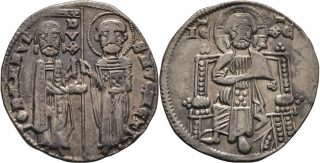
Silver grosso of Giovanni Dandolo, Doge of Venice from 1280 to 1289
The silver grosso was introduced in Venice in 1193 to provide a fine trading currency that was acceptable outside Venice. It was initially 2.18 grams of 98.5 % pure silver. The rulers of Venice during the medieval period were called Doges.
The obverse of the grosso shows the standing figures of the Doge (left) holding a staff and St. Mark holding the gospel. St. Mark is presenting the Doge with his coronation oath. The obverse legend names the doge (in this case Giovanni Dandolo – 1280-1289 -IO.DANDVL) on the left and his title DVX top centre. The right hand obverse legend names St. Mark of Venice – S.M.VENETI.
The reverse of the grosso shows Christ facing, sitting on a throne. The legend abbreviates His greek name IC XC.
The grosso was issued with this design for over 150 years. However after 1340 the rising silver price resulted in low mintages or reduced weight. The last grosso was issued around 1470 and weighed only 0.45grams. Doges continued to rule Venice until 1797 when it was conquered by Napoleon.
Grossos of Venice survive in considerable numbers so are available to collectors at moderate prices, particularly from European dealers. However putting together a collection of grossos of the various doges would be a challenge.